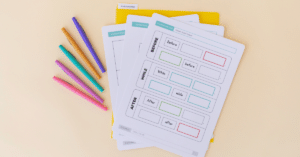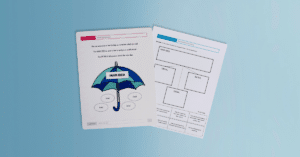I just got to present at the SLP Summit and had the. best. time!
Missed us live? The replay is available until August 7th!
I presented 5 simple tools that SLPs can use to step up their narrative intervention.
There were a lot of questions, so I’m going to take some time to answer them here! 💛
Narrative Intervention Strategies
Do you only use stories that have all of the story grammar elements in that order?
I may start with simpler stories that are structured “perfectly”, but I like to teach students to identify the story grammar elements in real picture books. I do skim the story to make sure that the character, setting, initiating event, emotions, plan, action/attempt, and consequence are clear.
Do you start with all of the story grammar markers or do you just start with a few? If so, which do you start with?
I typically start with Characters, Setting, Initiating Event, Internal Response, Plan, Action/Attempt, and Consequence.
Before you start the unit, do you introduce each grammar icon?
I introduce the icons in the context of the story (e.g., “The setting tells us when and where the story happened. Where did this story happen?”).
Do you reread the story at the beginning of every session?
I do not! It really depends on the group. I do like to share the YouTube video with the teacher and/or parents so that the students have a chance to get multiple exposures to the story in between sessions.
Do you draw the pictographs and fill in story maps? Or do you have the student do it?
This also depends on the dynamic of the group! I do like to have students take ownership whenever possible.
How do you fade the visual support?
Here’s one example of what that could look like:
In the first retell of a story, provide the story grammar icons and pictographs.
On the second retell, provide the story grammar icons. Show the pictographs as needed (or when a verbal cue does not work).
Only the fourth retell, don’t provide any visual supports unless the student gets stuck.
Do you move from pictures to icons (and then to faded prompts) within one session or over multiple sessions?
This also depends on the student and what they need! My goal is to provide just the right amount of support. I want to challenge the student for optimal learning, but I don’t want them to be frustrated in the process.
I find students can pick up the story elements and identify them relatively easily with direct instruction. However, I see a lot of breakdowns with them being able to independently put it all together to tell a story without statements like “The character’s in the story are…” and The setting is…” Any input?
I found that modeling alternative sentences does the trick! Especially if they’re consistently able to produce the narrative using their “template” sentences.
Narrative Intervention Across Your Caseload
What does this look like at the kindergarten level?
I would use a picture book (versus a fiction article). The five tools I shared would absolutely still apply though! The fundamentals are still the same!
Is narrative intervention utilized with older students as well?
Absolutely! Check out this article for a really cool example of what this could look like.
Gurney, D., Gersten, R., Dimino, J., & Carnine, D. (1990). Story grammar: Effective literature instruction for high school students with learning disabilities. Journal of Learning Disabilities, 23(6), 335–342.
Any thoughts on targeting narratives with children who use AAC?
Do it! One of my professors in grad school harped on the importance of exposing students who use AAC to literacy and narratives. Meet the student where they’re at (of course), but I love modeling narratives using AAC.
Any suggestions for targeting these goals with students who have attention difficulties?
I’d recommend checking out Tera Sumpter’s resources. I’m not the best SLP to explain this!
Do you have examples of teletherapy?
I don’t, but the tools and strategies would still apply! You’d simply use digital versions of the icons/graphic organizer. And yes! We do have this in the SLP Now library.
Narrative Goals
How do you address non-narrative goals within this framework?
Narratives are language rich and are prime content to target virtually any goal. For example, if I’m targeting a grammar goal (e.g., past tense verbs), the student will have the opportunity to produce past tense verbs throughout the unit. If I’m targeting a vocabulary goal (e.g., naming items in categories), the student will have the opportunity to identify items in categories throughout the unit. Want more detail? Check out this free challenge!
How do you write goals?
I don’t change my goals for a narrative approach! I write goals based on the skills that my students need support with. Any goal can be targeted using a narrative and/or literacy-based approach.
Narrative Materials
Where can we obtain these icons?
They are available in the SLP Now membership!
Where can I obtain a graphic organizer like yours?
They are available in the SLP Now membership!
Are the sentence starters with the graphic organizer in your membership?
Yes!
What are you using that is captioning what your students say during the videos? It would be a great way to look at a student’s responses later or for students to “see” what they are saying as well as hear it. I love the color and the larger words.
I’ve never used the captioning with students! I just created the captions to make it easier for you to understand the students’ stories. The app that I used is called Descript.
Expository Texts
How could you use these with expository texts?
I use a different set of strategies/techniques when targeting expository texts with students!
How do we bridge fictional narratives (with characters, settings, etc.) with expository texts?
I typically just switch to teaching expository texts once the students no longer demonstrate a need for narrative support. I’m not aware of any research-backed strategies to bridge from narratives to expository texts.
Data Collection
What is the best way to take data during narrative intervention?
I have a FREE bootcamp/challenge that dives into my data collection system. Check it out here!
Are the probes related to the story or not?
If I’m probing their ability to retell a story, I typically do just use the story. I tend to use unrelated probes for other skills. (The bootcamp that I mentioned explains that in more detail!)
How would you probe wh-questions without reading a full text? Wouldn’t that take a long time in a mixed group?
It depends on how the goal is written! If the goal is written in that way, I may pull the student separately, set up the session to allow for an extended probe (e.g., by giving the students another activity to work on), or ask the questions right after reading the text for the current unit.
What data did you collect when doing the parallel story?
The Digital Data Bootcamp goes into more detail, but I collect probe data at the very beginning of the session. I then collect data on how the students perform in context. For example, if they have a goal to produce past tense verbs, I will keep track of the level of support that they need to produce past tense verbs in this context.
Literacy-Based Therapy
Any tips for introducing or pivoting to more narrative-based therapy with groups/students who are used to games?
Bring the excitement! If you’re excited about the activities, your students will be too! Communication is naturally reinforcing. It might also be beneficial to start with a very high-interest story, select texts that include the students’ interest, and/or incorporate technology (e.g., YouTube videos, drawing on the iPad).
How long does a unit last?
My literacy-based therapy units typically last a month. If you want to learn more about how I structure a unit, I’d highly recommend this free challenge. You’ll get to see examples of units and build your own!
How do you handle student absences? Are they behind if they miss the previous session?
That is a great question! It depends on so many factors (where we were in the unit, the student’s strengths/needs). I may re-read the text with the group if I think that would be beneficial. Another option is to have the student listen to the YouTube video of the book prior to the session or while I collect probe data.
What are some of your favorite books to use for lower grade levels? Upper grade levels?
Here is a list of my favorite picture books, and I love using ReadWork’s fiction articles for my older students.
Are parallel stories written/drawn by students (mini books), just verbal, or written in a graphic organizer with everyone’s ideas (small group school sessions)?
All of the above! There aren’t any set rules, and you get to decide what works best for your group and the goals you’re trying to target.
SLP Now
Does SLP Now mostly focus on narrative intervention? Are there any screening/evaluation tools?
We do have hundreds of resources to support you with narrative intervention, but we offer a wide range of materials–including assessments, visuals to teach a variety of skills, articulation activities, social language units, function communication units, and more! Feel free to sign up for a free trial to check out the entire library of materials!
Does your membership have an outline to help you with a month-long literacy-based therapy unit?
Yes! We built out Therapy Plans to do just that! Here’s a quick overview.
Will SLP Now help address goals for older students?
Yes! This article lists all of the goals and units that we offer for various ages.
Will SLP Now help address social skills goals?
Yes! We do offer social language units.
Do you have any bilingual (Spanish) materials available?
Yes! We currently have two book units and are working with a bilingual SLP to create more!




Reader Interactions